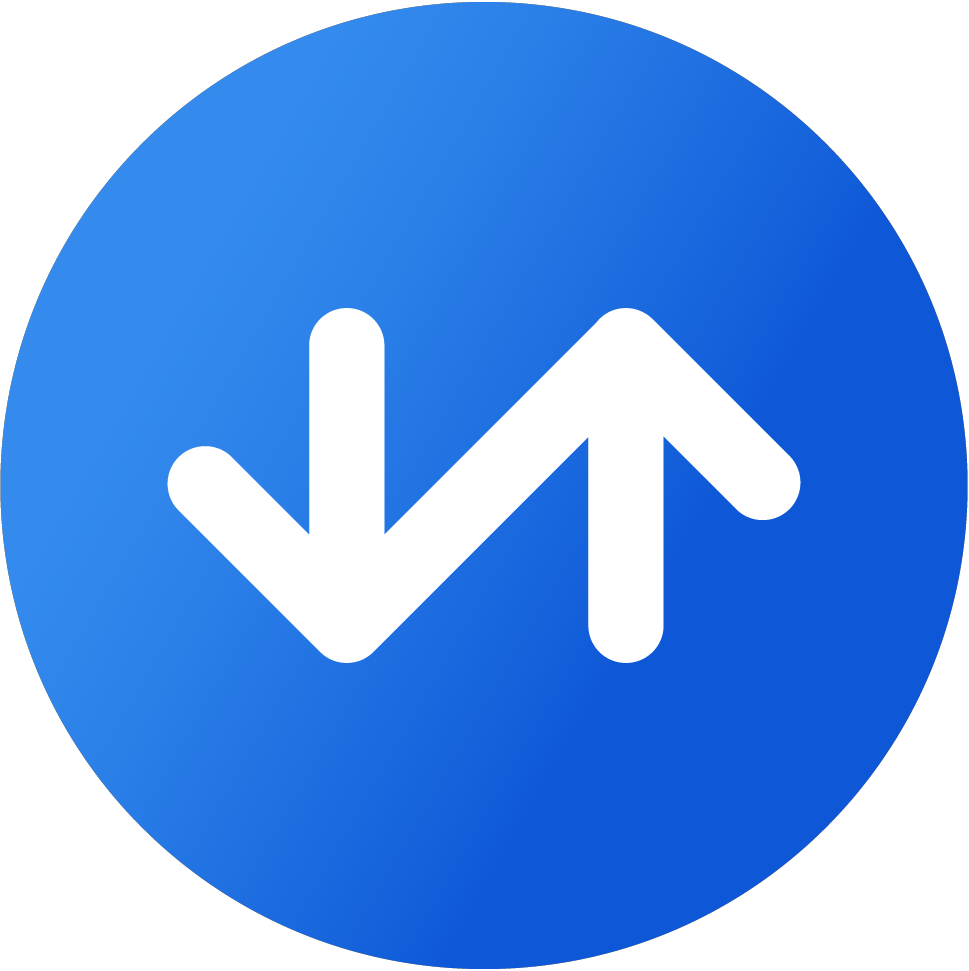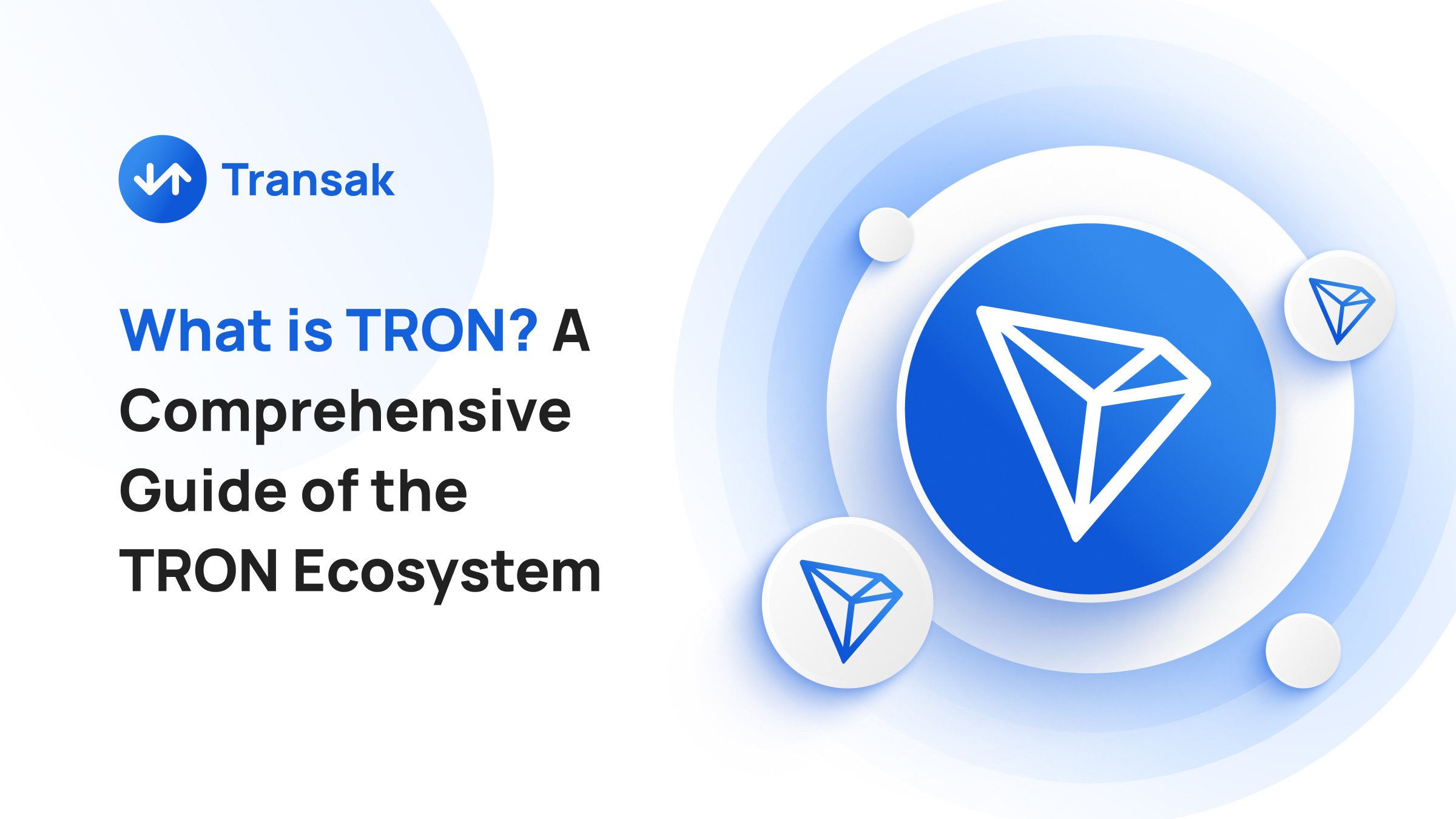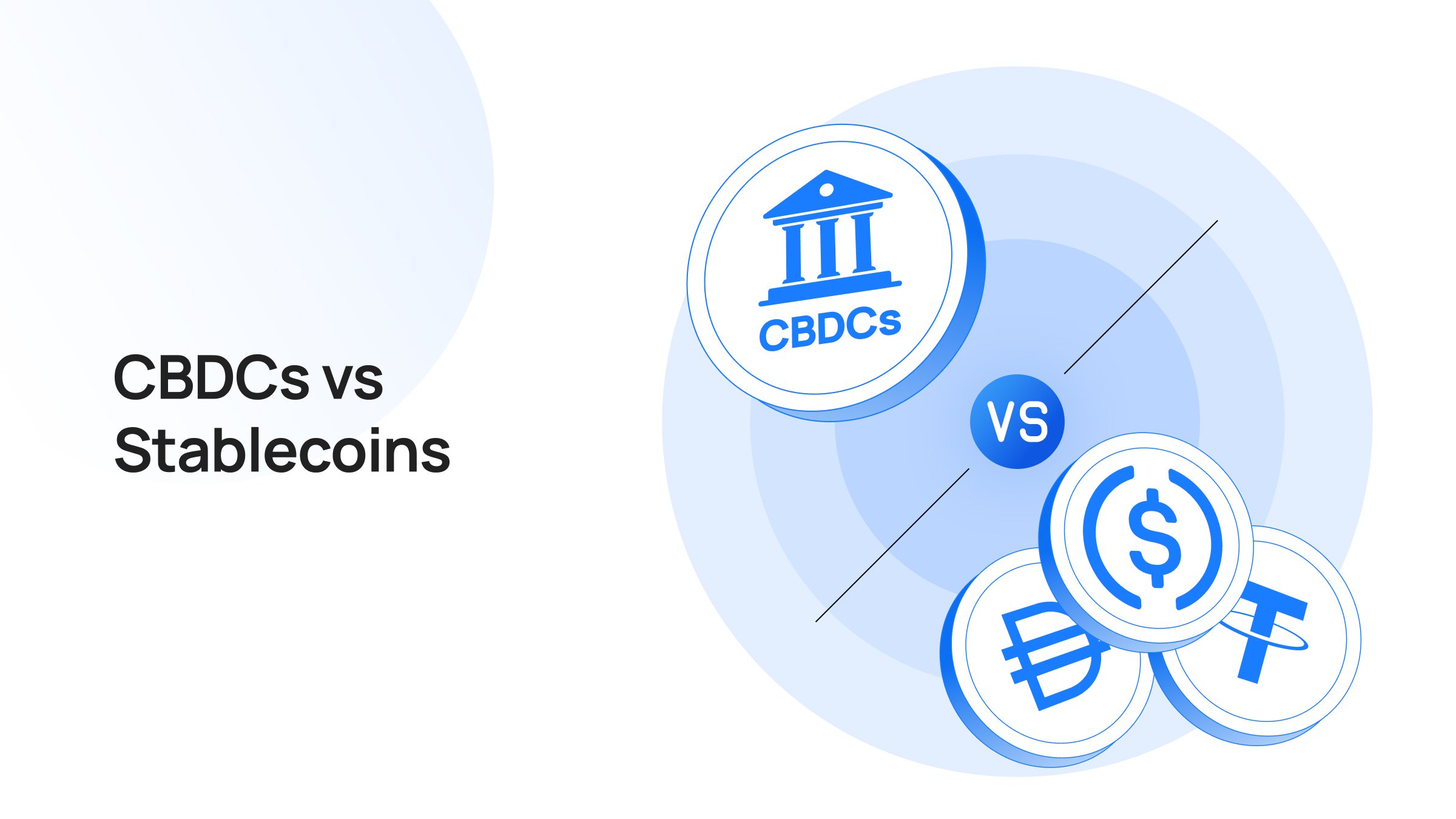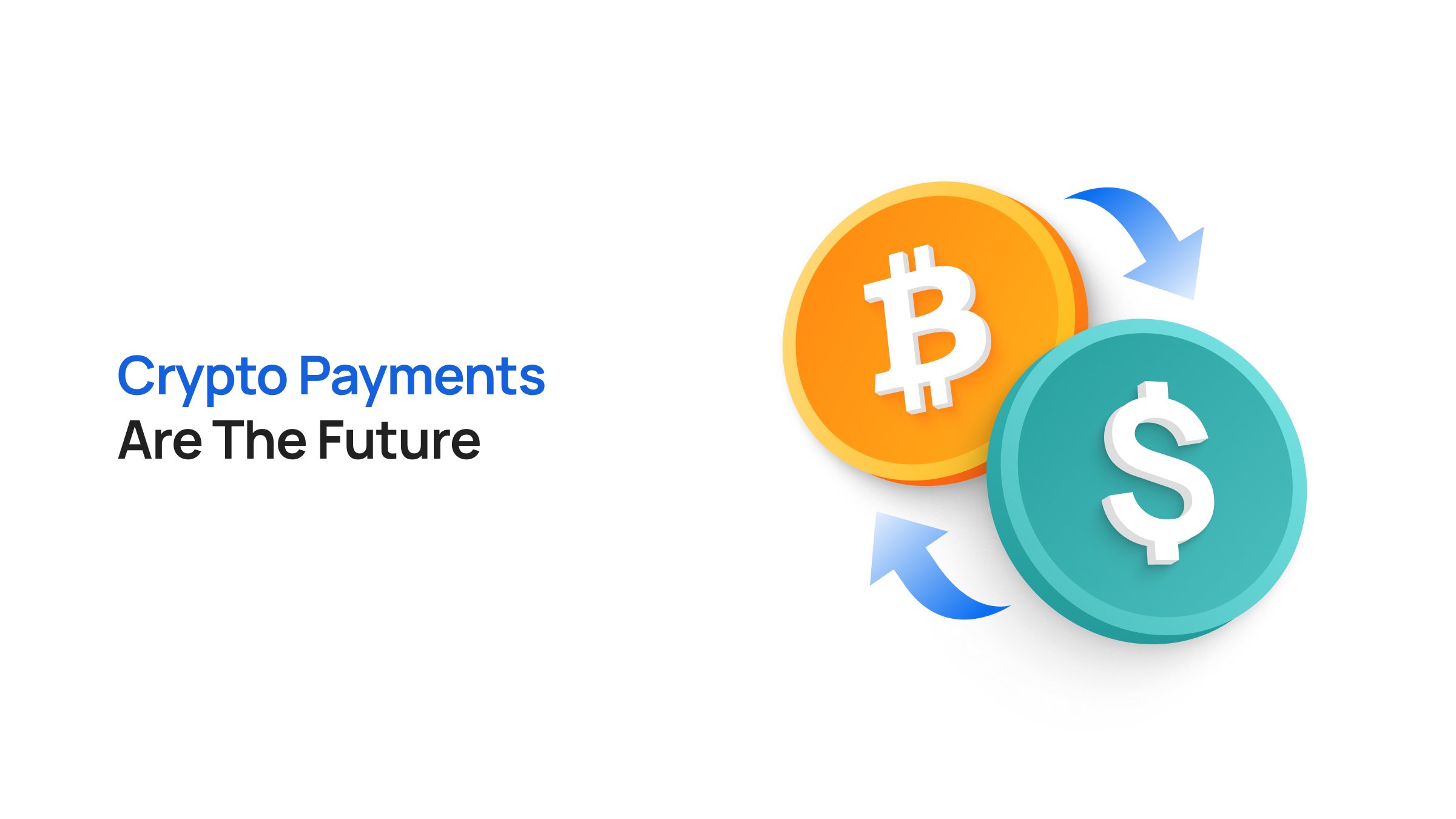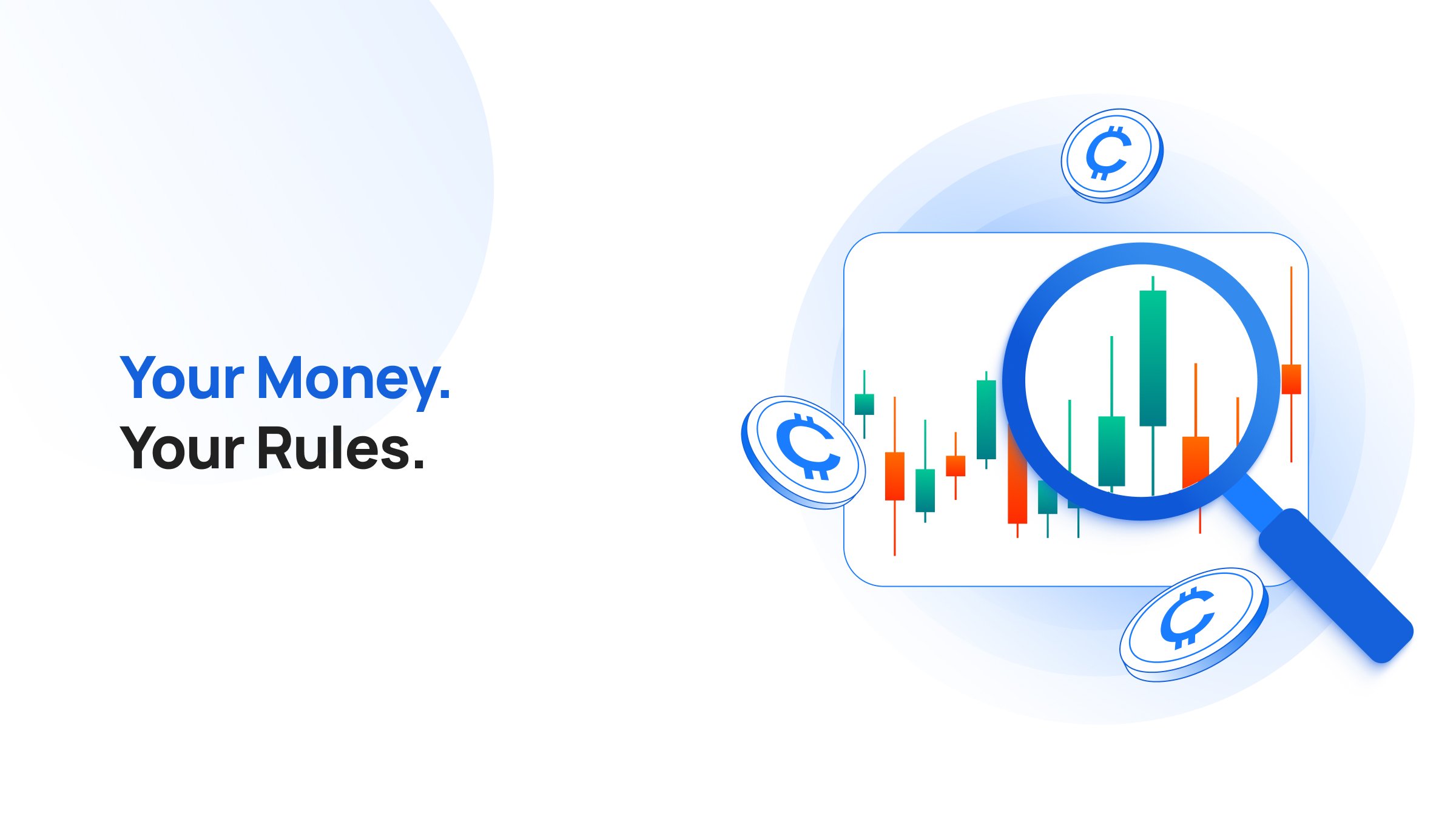The blockchain presents a wonderful opportunity for creators to publish content with provable ownership, form tight-knit communities, and be the decision-makers of their own royalties.
Unfortunately, DLT system, as they were originally designed, did not take this use case into account. So, while it was theoretically a utopia, it was just that — a theory. Until TRON.
TRON is a blockchain-based platform designed to empower creators and consumers alike, offering them a decentralized haven where they can interact directly, free from intermediaries and gatekeepers.
Built upon a vision of a content-centric ecosystem, TRON has garnered considerable attention for its ambitious goals and innovative features. At the time of writing, over $8 billion worth of assets are locked in the TRON ecosystem.

This article explores the TRON blockchain and Transak’s support for the network.
What is TRON?
TRON, at its essence, is a decentralized blockchain platform meticulously crafted to revolutionize the entertainment and digital content industries.
Established in 2017 by Justin Sun and overseen by the TRON Foundation, its overarching goal is to disrupt the long-standing, centralized models that have dominated how content is created, distributed, and consumed. TRON envisions a future where creators have greater autonomy and control over their work, and consumers can directly engage with and support the content they enjoy.
The platform operates on its native utility cryptocurrency, TRX, which serves as the lifeblood of the ecosystem.
TRX tokens are used for various transactions within the TRON network, including content purchases, voting rights, and participation in decentralized applications (dApps) built on the platform. It also incentivizes users to contribute to the network's overall functionality, creating a self-sustaining ecosystem.
The TRON Foundation provides financial support and resources to developers and projects within the TRON ecosystem through TRX cryptocurrency. This support helps foster innovation and growth, enabling the creation of a diverse array of dApps and blockchain solutions.
It is important to note that the TRON Foundation completed its mission and dissolved itself in July 2021. This marked the restructuring of TRON Foundation into TRON DAO, a new organization launched with community support to continue overseeing and supporting the TRON network.
How the TRON Network Works: A Detailed Technical Overview
TRON network’s architecture and functionality are tailored to meet the demands of a decentralized internet.
Architecture
The TRON network operates on a three-layer architecture:
- Storage layer
- Core layer
- Application layer
1. Storage Layer
TRON's unique storage layer uses both block storage and state storage.
Block storage, similar to traditional blockchains, stores transaction history, while state storage maintains the most recent state of accounts and smart contracts. Notably,
TRON adopts a graph database structure for its state storage, optimizing data query efficiency and enabling complex relationship mapping within the network.
2. Core Layer
The core layer is where the magic happens. It encompasses three main modules:
- Smart Contract Module: This module facilitates the creation and execution of smart contracts written in Solidity or other compatible languages. TRON's smart contracts enable a wide range of use cases, from decentralized finance (DeFi) to non-fungible tokens (NFTs).
- Consensus Module: TRON employs a Delegated Proof of Stake (DPoS) consensus mechanism. TRX holders vote for 27 "Super Representatives" (SRs) who validate blocks and maintain the blockchain's integrity. The SR selection process occurs every six hours, ensuring decentralization and incentivizing participation through block rewards.
- Account Management Module: This module manages accounts, permissions, and balances within the network. It ensures secure and transparent transactions while upholding the principles of decentralization.
3. Application Layer
The application layer provides developers with a comprehensive suite of tools and interfaces to build decentralized applications (dApps) on the TRON network.
It includes APIs for smart contract interaction, wallet integration, and event triggers. Developers can leverage these tools to create a diverse array of dApps, from games and social networks to financial platforms.
Consensus Mechanism
TRON's Delegated Proof of Stake (DPoS) consensus mechanism is a unique and efficient way to maintain the network's integrity and security.
In TRON's DPoS, the TRON community elects 27 Super Representatives (SRs) through voting. These SRs are responsible for validating blocks and creating new blocks on the TRON blockchain. The voting process is continuous, with a new cycle occurring every six hours. This ensures that the SRs remain accountable to the community and can be replaced if they fail to perform their duties effectively.
To become an SR, candidates must stake a significant amount of TRX and gain the support of the community through votes. Once elected, SRs receive rewards in the form of TRX for their block production and validation efforts. This incentivizes them to act in the best interests of the network and maintain its security.
The DPoS mechanism is designed to be highly efficient and scalable. Compared to PoW, it requires significantly less computational power, making it more energy-efficient and environmentally friendly. Additionally, it allows for faster block times and higher transaction throughput, making TRON well-suited for handling a large volume of transactions.
One potential drawback of DPoS is that it is more centralized than PoW. However, TRON has implemented several measures to mitigate this risk, including regular SR elections, the ability for TRX holders to vote out underperforming SRs, and the use of a large number of SRs (27) to ensure a degree of decentralization.
TRON Virtual Machine (TVM)
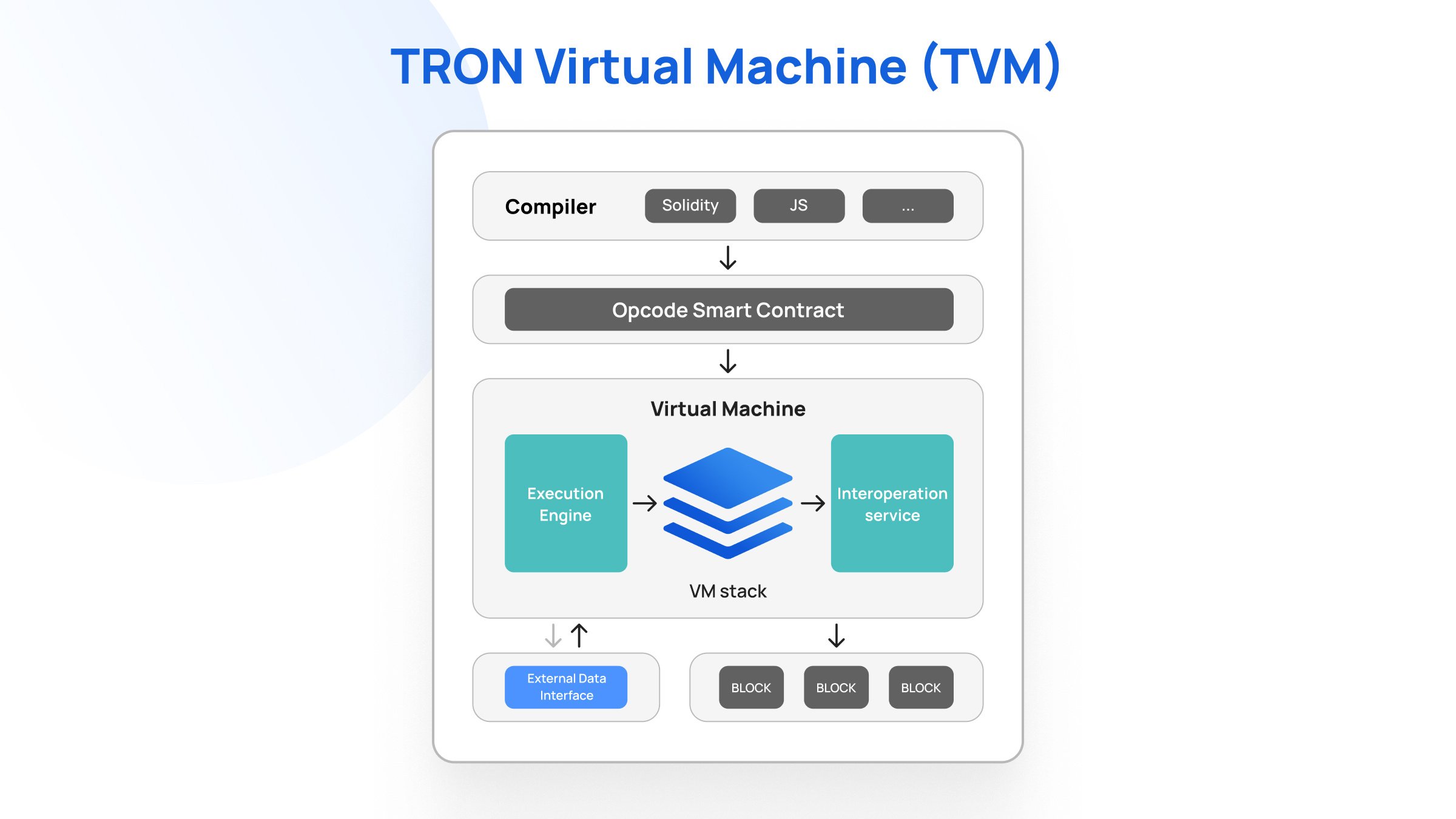
The TRON Virtual Machine (TVM) is a lightweight, Turing-complete virtual machine developed by TRON to execute smart contracts on the TRON blockchain. It is an integral part of the TRON ecosystem, providing a high-performance environment for decentralized applications (dApps) and facilitating the seamless migration of Ethereum dApps to the TRON network.
A key feature of the TVM is its initial compatibility with the Ethereum Virtual Machine (EVM). This compatibility allows developers familiar with Ethereum's Solidity programming language and tooling to seamlessly transition to TRON, porting existing Ethereum dApps or creating new ones with minimal friction. While initially designed to mirror the EVM, TRON has gradually evolved the TVM to include unique features and optimizations tailored to its specific needs and goals.
The TVM operates on a stack-based architecture, executing bytecode instructions within a sandboxed environment. This ensures that smart contracts are isolated from external resources and cannot interfere with the underlying blockchain or other contracts.
Additionally, the TVM employs a metering system, where each instruction consumes a certain amount of "energy." This mechanism prevents infinite loops and denial-of-service attacks, ensuring the network's overall stability and security.
Development Tools and Environment
Compiler
The TVM uses a Solidity compiler to convert high-level smart contract code into bytecode that can be executed by the TVM. This compiler is compatible with standard Solidity, making it easy for developers familiar with Ethereum to transition to TRON.
Integrated Development Environment (IDE)
TRON provides a robust development environment with tools like TronBox, TronGrid, and TronStudio, which facilitate the development, testing, and deployment of smart contracts on the TRON network.
- TronBox: A framework for developing, testing, and deploying smart contracts.
- TronGrid: Provides API services for interacting with the TRON blockchain.
- Tron IDE: An IDE that offers an integrated environment for writing, testing, and debugging smart contracts.
Debugger
A built-in debugger allows developers to step through their smart contract code, identify issues, and ensure the correctness of their contracts before deployment.
Enter the TRON DAO
TRON DAO is the governance structure that oversees the TRON blockchain network. It embodies the principles of decentralization and community-driven development, ensuring that the TRON protocol evolves according to the collective interests of its participants.
It allows TRX holders to participate in the governance of the network through a decentralized voting process. The governance model ensures that all changes and updates to the network are decided by the community rather than a centralized authority.
TRX holders can vote on various proposals, including:
- Electing Super Representatives (SRs)
- Proposing and voting on network upgrades
- Allocating funds for development projects
- Making policy changes regarding the network’s operation
Votes are weighted based on the amount of TRX staked by each participant, ensuring that those with a larger stake in the network have a proportionate influence on decisions.
Super Representatives play a crucial role in TRON DAO’s governance:
- Election: 27 SRs are elected by the community through a voting process. TRX holders can vote for their preferred candidates, who then serve as validators for the network.
- Duties: SRs are responsible for producing blocks, validating transactions, and maintaining network security. They also participate in governance decisions and propose changes or upgrades to the network.
- Rewards: SRs receive rewards for their contributions, which they can share with their voters as an incentive for continued support.
Decision-Making Process in TRON DAO
1. Proposals
Any TRX holder can submit a proposal for changes or improvements to the network. Proposals can range from technical upgrades to policy adjustments and community initiatives.
2. Voting on Proposals
Once a proposal is submitted, it is subject to a voting period where TRX holders can cast their votes. The proposal must receive a majority vote to be implemented.
3. Implementation
Approved proposals are implemented by the SRs, who update the network according to the community’s decisions. This process ensures that all changes are in line with the collective will of the TRON protocol’s participants.
Top TRON Wallets
Several top-tier wallets have emerged as popular choices for storing and managing TRX and other TRON-based tokens. Here are a few standout options, including TotalSig:
- TronLink: Officially endorsed by TRON, TronLink boasts a user-friendly interface and is available as both a mobile app and a browser extension. It allows users to securely store, send, and receive TRX, along with various TRC-standard tokens. TronLink also features built-in support for decentralized applications (dApps) and staking, enhancing its utility within the TRON ecosystem.
- Trust Wallet: As a multi-currency wallet, Trust Wallet supports a wide range of cryptocurrencies, including TRX. It offers a secure and convenient way to manage your TRON assets, with features such as staking and dApp browsing. Trust Wallet's mobile-first approach makes it a popular choice for users on the go.
- Atomic Wallet: This non-custodial wallet is known for its user-friendly interface and support for a vast array of cryptocurrencies, including TRX. It allows users to easily exchange, stake, and manage their TRON tokens, while also providing access to a decentralized exchange (DEX) for seamless token swaps.
- Ledger Wallets: For users prioritizing maximum security, hardware wallets like Ledger Nano S and Ledger Nano X are excellent choices. These physical devices store your private keys offline, offering enhanced protection against hacking and theft. Ledger supports TRX and other TRON-based tokens, ensuring that your assets remain safe and secure.
- TotalSig: TotalSig is a unique multi-signature wallet designed specifically for TRON. It requires multiple parties to authorize transactions, providing an additional layer of security for high-value transactions or shared wallets. TotalSig is a popular choice for businesses and organizations that need to manage TRON assets collaboratively.
Transak Supports TRON
TRON has witnessed a surge in popularity and adoption in recent years. Its focus on the entertainment industry, decentralized applications (dApps), and fast, low-cost transactions has attracted a large and active community of users. By supporting TRON, Transak allows users with a seamless entry into the TRON ecosystem through fiat currency and familiar payment methods like Apple Pay, credit cards, debit cards, and bank transfers.
How to Buy USDT on TRON Using Transak
Transak offers a user-friendly interface that simplifies the process of purchasing USDT. Users can follow these straightforward steps:
- Select USDT on TRON: On the Transak platform, choose USDT and specify that you want it on the TRON network.
- Enter Purchase Amount: Specify the amount of USDT you wish to purchase.
- Choose Payment Method: Select your preferred payment method, such as a credit/debit card or bank transfer.
- Complete KYC: Complete the Know Your Customer (KYC) verification process, if required.
- Receive USDT: Once the payment is processed, the USDT will be transferred to your TRON wallet address.
Conclusion
TRON has already established a robust and dynamic ecosystem, boasting a wide array of decentralized applications (dApps) spanning gaming, DeFi, NFTs, and content creation.
The acquisition of BitTorrent and its integration with the TRON protocol has opened new avenues for decentralized content sharing. BitTorrent’s massive user base, combined with TRON’s blockchain capabilities, creates a unique synergy for distributing digital content.
TRON’s support for stablecoins, particularly USDT-TRC20, has significant implications for global payments and financial inclusion. The ability to transact with stablecoins on TRON’s network offers a stable and efficient means of transferring value, especially in regions with volatile local currencies.
